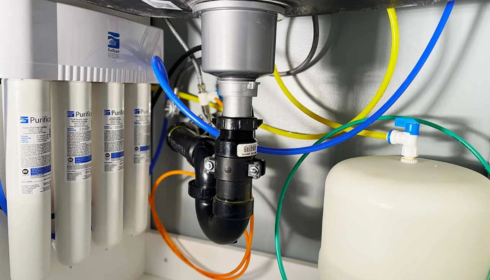Water might seem like the most ordinary thing in the world, but for businesses, it’s a quiet powerhouse. Whether it’s keeping equipment running smoothly, ensuring safe products, or simply cutting down on waste, water treatment has become less of a “nice-to-have” and more of a “must-do.” It’s not just about meeting regulations anymore—it’s about staying competitive, efficient, and responsible in a world that’s paying more attention to sustainability.
What’s interesting is how this shift didn’t happen overnight. For years, many companies treated water like an endless resource. But reality eventually catches up. Rising costs, stricter environmental policies, and growing public pressure have made industries rethink their approach. Today, the focus is on smarter solutions—technologies that not only clean water but also help businesses use it more effectively. That’s where the world of commercial water treatment steps in.
The Backbone of Modern Industry
Think about food processing plants, pharmaceutical labs, or even hotels. None of these can run properly without clean, reliable water. It’s not only about hygiene but also about protecting machinery, ensuring product quality, and avoiding downtime. One unnoticed issue—say, mineral build-up in a boiler—can quickly snowball into expensive repairs or even production stoppages.
This is where having a tailored treatment plan matters. Unlike household systems, the needs of large-scale operations are complex. Water coming in may have different contaminants, depending on the region, and the requirements for output water can vary wildly. A brewery, for example, doesn’t just need “clean” water—it needs water that enhances the flavor profile of its product. An electronics manufacturer, on the other hand, needs ultra-pure water that won’t interfere with delicate components.
Technology Leading the Charge
It’s easy to imagine water treatment as a simple filtering process, but modern solutions are way more sophisticated. Automated monitoring systems, advanced filtration methods, and AI-driven analysis are now part of the mix. This means companies can not only clean their water but also track usage, predict maintenance issues, and optimize efficiency.
The variety is staggering too. From softening hard water to removing pathogens and heavy metals, treatment systems can be customized to fit nearly any requirement. And let’s not forget the energy-saving aspect. Older methods often consumed a lot of electricity, while new-generation systems are designed with efficiency in mind—reducing both carbon footprints and utility bills. Businesses that once saw treatment as a burden now see it as an investment.
One of the most versatile solutions in the market today is industrial water purification systems. They’re built to handle massive volumes, consistently delivering high-quality results. Industries that rely heavily on water—like textiles, chemicals, or power plants—often depend on these systems because they can’t afford inconsistencies. The reliability factor is crucial: when water quality is stable, production runs smoothly, and risks of costly interruptions are minimized.
Why Reverse Osmosis Still Stands Out
Of all the technologies out there, reverse osmosis remains one of the most widely adopted. The concept is simple but effective: force water through a semi-permeable membrane to separate impurities. But in practice, the design has been refined for decades, making it one of the most trusted methods in commercial and industrial settings.
A commercial reverse osmosis system is especially valuable for operations that need extremely pure water. Hospitals, for instance, use RO systems for dialysis units, while beverage companies use them to maintain consistency in taste. What’s impressive is how scalable these systems are. Small businesses can install compact units, while large industries can have sprawling networks that handle thousands of gallons daily.
Beyond purity, reverse osmosis helps cut down on reliance on bottled water, reduces logistical costs, and even supports sustainability goals. Businesses that adopt RO systems often highlight them in their corporate responsibility reports because they align neatly with eco-friendly initiatives.
Sustainability as a Business Driver
It’s no secret—customers today are paying closer attention to where their money goes. Many prefer brands that demonstrate real environmental responsibility. This cultural shift has made water treatment more than a technical concern; it’s now part of branding and public image.
Companies that recycle wastewater, reduce discharge, or minimize chemical use aren’t just saving money—they’re telling a story that resonates with employees, clients, and regulators alike. In some industries, having sustainable practices isn’t just attractive, it’s required to win contracts or meet global standards.
There’s also a financial logic to it. Treated water often means less wear and tear on equipment, fewer compliance fines, and reduced operating costs. Over the long term, these savings can be significant. That’s why forward-thinking businesses don’t see water treatment as an expense but as a way to future-proof operations.
The Road Ahead
The world is only getting thirstier—both literally and figuratively. Population growth, urban expansion, and climate shifts are putting immense pressure on water resources. For businesses, this means adapting now rather than waiting for a crisis. Those who invest in smart systems will not only safeguard their operations but also contribute to a bigger global goal: responsible water use.
It’s not about perfection or solving everything overnight. It’s about progress. Every step—whether it’s installing a new filtration unit, upgrading to energy-efficient pumps, or reusing greywater—adds up. And when enough businesses commit to better practices, the ripple effect can be transformative.
Final Thoughts
Water treatment might not sound glamorous, but it quietly underpins much of our modern life. For industries, it’s a balancing act between operational needs, environmental responsibility, and financial sense. Thankfully, the technology exists to make that balance achievable.
The companies that embrace innovation in this space are not just checking boxes for compliance—they’re shaping a cleaner, more sustainable future. And when you think about it, there’s something deeply reassuring in that. Because at the end of the day, clean water isn’t just good for business—it’s good for everyone.





